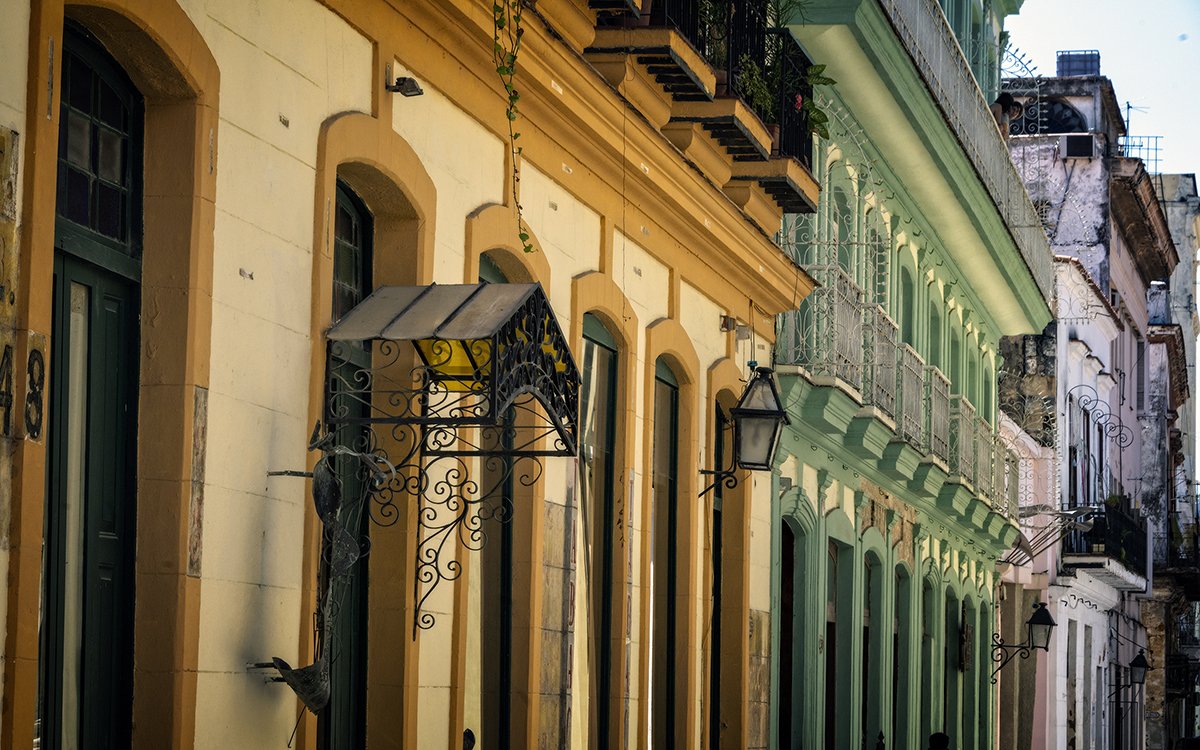A Look Inside: “Mobile and Havana: Sisters Across the Gulf”
The bright colors of Havana, photograph by Chip Cooper for Mobile and Havana: Sisters Across the Gulf, 2024
2024This new book is an engaging blend of history and photographs, demonstrating how these “Caribbean” cities are linked – through culture, commerce and architecture.
– by Thomas Uskali
Lit Life columns are underwritten in part by Karen Hinton and Howard Glaser
As writers of Mobile and Havana: Sisters Across the Gulf, John Sledge, who served as architectural historian for the City of Mobile for 38 years, and Alicia García-Santana, historian of Cuban architecture and urbanism, have worked in tandem, each focusing on their areas of expertise.
In the first section, “Sisters Across the Gulf,” Sledge offers an historical perspective with fascinating vignettes of key figures and events. García-Santana’s section, “The Shared Heritage,” is an architectural tour from the 16th century onward.
Theirs are distinct yet complementary voices in this luxurious production with full-page photographs throughout. Chip Cooper and Julio A. Larramendi’s masterful photographs document the beauty and history so well described by the authors.
Sisters Across the Gulf
1906 ad for regular steamship service between Mobile and Havana. The price included a comfortable stateroom, an electric fan and an attentive white-jacketed steward. Wikamedia
An antebellum traveler noted, “with the exception of New Orleans and Havana, there was no commercial mart on the Gulf of Mexico as thriving as Mobile.” Since the route from Mobile to Havana didn’t require the circuitous lower Mississippi River passage required for New Orleans, the trip was fast by nautical standards of the day between these two “neighbor” cities.
Sledge anchors history through key people and their stories, with snapshots of narrative covering a long span of history.
In 1506, Sebastián de Ocampo of Spain confirmed that Cuba was indeed an island (Christopher Columbus didn’t believe what he’d been told by the native Taínos people). Ocampo also charted the protected natural port that is now part of Havana.
Spain soon began conquest of the island; the lure of riches and power eventually brought Hernando de Soto in 1538. He was named governor or Cuba and adelantado of Florida, which included all of present-day coastal Alabama and Mississippi (West Florida).
But unlike the gold found by early conquistadors in Central America, there was only “meagre plunder” to be found in Cuba and the Mississippi Valley. De Soto reached what is now Alabama in 1540 and attacked the indigenous people in Mabila, near present-day Montgomery. Mobile was later named to honor the native population.
The Giraldilla, beloved symbol of Havana, by Chip Cooper for Mobile and Havana: Sisters Across the Gulf, 2024
Spring Hill College, Lucey Administration Building, Mobile. This 1869 building replaced an earlier one lost by fire. Photo by Chip Cooper
Mobile was founded in 1702 by explorer Pierre Le Moyne d’Iberville as part of a French strategy to control the Mississippi Valley. Mobile Bay, while relatively shallow, offered protected Gulf access, was near Dauphin Island as a port for large vessels, and gave access to the territory’s interior through a vast river network. Iberville died of yellow fever in Havana and was buried there in 1706. Twelve years later, d’Iberville’s brother Bienville founded New Orleans (1718), making an interesting link of all three cities to France.
In order to bring “suitable” female settlers to Mobile, d’Iberville helped transport French women to the city by way of Havana in 1703. Unfortunately, the twenty-four girls (aged 14-19) were also carriers of yellow fever, likely contracted in Havana. And in 1719, the first enslaved Africans were brought to the settlement of about 350 people.
The 7-Years War (1756-1763, also called the French and Indian War) brought shifts in power and territorial changes to the Caribbean and American colonies. The centuries-long entanglements among the English, Spanish, and French are described in enough detail for the casual reader; they will likely pique one’s interest in further research.
The Morro Castle at the entrance to Havana Harbor, Chip Cooper for Mobile and Havana: Sisters Across the Gulf, 2024
Sledge describes the Civil War-time alliances of Confederate States with Cuba (and therefore Spain) as a careful dance, navigating blockade running and shady dealings throughout the war. Mobile “managed quite well during the war’s first years,” and was even called the “Paris of the Confederacy” for its relative luxury.
Local institutions carried on, even Spring Hill College, where Havana natives Nemesio and Ernesto Guillo and Enrique Porto were sent by their parents in 1858. They made it back to Cuba in 1864 and brought a local game back with them: “village ball,” “town ball,” or “base ball.” Their fervor led directly to it becoming Cuba’s national pastime.
Trade between Mobile and Havana grew steadily starting in the 18th century, with timber from Alabama and exotic goods from Cuba, including bananas, coconuts, manganese, and coffee by the second half of the 19th century.
In fact, Mobile’s trade with Cuba exceeded that of all its other foreign ports. By 1912, the fastest passenger voyage from Mobile to Havana took only 36 hours, and in the 1920s, Prohibition in the U.S. further increased tourism to Cuba.
The Shared Heritage
In the second half of the book, García-Santana traces the interrelationships of architectural influences (Spanish, French, English) in the Caribbean, noting key examples from St. Augustine, Charleston, New Orleans, Mobile and Havana. She describes the architectural unity of the Spanish-ruled Caribbean, with elements that made their way to America and remain part of the vernacular. One chapter, “New Orleans: Where French and Spanish Meet,” highlights several French Quarter examples of that melange.
Madame John’s Legacy (1788), 632 Dumaine Street, French Quarter, New Orleans, photo by Julio Larramendi, Mobile and Havana: Sisters Across the Gulf, 2024
While the earliest Spanish structures in 16th century Cuba were built as fortresses, later homes of the colonial period incorporated interior courtyards, an idea borrowed from Moorish architecture. This layout also suited grid-based town designs in the New World.
Havana is one of the few Caribbean cities that “retains the urban coherence of its heritage area” and much of its original architecture. Castile architecture in the thriving city became a template for Spanish colonies; the spaces that connected indoors with outdoors (balconies, galleries, and the zaguán, or atrium) are seen in various iterations.
Founded in 1565, St. Augustine demonstrates how English sensibilities, such as front courtyards open to the street, blended with the original Spanish buildings and city layout; it’s an example of architectural fusion and the overarching theme for this portion of the book.
As García-Santana notes, “East Florida, West Florida and Louisiana have examples that can only be explained by the cultural mix of Spanish, French, British and North American cultures.”
1031 - 1043 Chartres Street (1824), French Quarter, New Orleans, photo by Julio Larramendi, Mobile and Havana: Sisters Across the Gulf, 2024
The Bosque House (1795) 617-619 Chartres Street, French Quarter, photo by Julio Larramendi, Mobile and Havana: Sisters Across the Gulf, 2024
New Orleans’ oldest architecture demonstrates both French and Spanish influences, such as the zaguán, taken from traditional Spanish architecture and modified to suit life in the busy French Quarter of the 19th century as the porte de cochère. Comparing the interior courtyard of Gallier House in New Orleans and the Ximenez-Fatio House in St. Augustine, one sees common elements and the variations wrought by time and culture.
Double parlors in Gallier House (1859 - 1860), home to the Gallier House Museum, residence of architect James Gallier, Jr., 1132 Royal Street, French Quarter, New Orleans, photo by Julio Larramendi, Mobile and Havana: Sisters Across the Gulf, University of Alabama Press, 2024
The Garnier House (1817), now Pat O’Brien’s Bar, photo by Julio Larramendi, Mobile and Havana: Sisters Across the Gulf, 2024
Mobile has retained some examples of early West Florida architecture, along with numerous details that were brought to the city by Cuban workers in the 19th century, including decorative encaustic tiles in the Christ Church Parish House that remain in place today.
García-Santana’s scholarly prose and the photographs by Cooper and Larramendi mesh beautifully, especially those from Havana, whose sights may not be familiar to readers. Numerous maps and aerial photographs situate the various buildings and underscore the unified design of this book as a whole.
The Oficina del Historiador de la Habana (Office of the Historian of the City of Havana) hosted the release of the Spanish language edition of Mobile and Havana: Sisters Across the Gulf on Saturday, November 16, 2024. Seated left to right are Chip Cooper, photographer; John Sledge, author; Magda Resik, director of Communications for the Office of the Historian; Alicia Garcia Santana, author; and Julio Larramendi, photographer. Photo courtesy Sydney Betbeze.
Of special note is the story of Eusebio “Leal” Spengler, city historian known as “The Man Who Saved Havana.” Mentored by Dr. Emilio Roig de Leuchsenring, Leal oversaw restoration of the baroque Captain General’s Palace fronting the Plaza de Armas.
In the late 1960s, Old Havana included 3,744 buildings, 551 deemed of “exceptional value” but in danger of being lost to redevelopment. Leal’s work with the Heritage Department of the Ministry of Culture (1976) brought results.
St. Francis de Asis Church in Havana, photo by photo by Julio Larramendi
By 1989, 68 buildings in Old Havana had been fully restored. Sadly, the collapse of the Soviet Union in 1991, coupled with the embargo that began in 1960 severely restricted trade, but a glimmer of connection remained.
Leal visited Mobile in 1994 at the invitation of Jay Higginbotham, a key figure in the “formal twinning” of Mobile and Havana. Higginbotham worked to maintain connections despite challenges brought by the embargo, and he is mentioned (and footnoted) often in the book.
During the Obama administration, loosening trade strictures opened Alabama to Cuban trade, which reached $33 million in 2014, but fell off during the next presidential administration. Nevertheless, one Cuban dignitary noted to Mobile, “We will never forget that you were the first. You will always hold a special place for us.”
Julio Larramendi and John Sledge in Havana, photo by Chip Cooper
Numerous Habaneros and a strong contingent of Mobilians attended the release of the Spanish edition of the book, which took place November 16, 2024, in the courtyard of the venerable Captain General's Palace fronting the Plaza de Armas in Old Havana. Photo courtesy Julio Larramendi.
Your support makes stories like this one possible –please join our Readers’ Circle today!

















